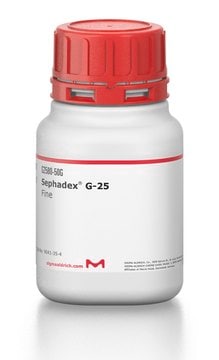SPC25120
SP Sephadex®
Synonym(s):
Sulfopropyl Sephadex®
Sign Into View Organizational & Contract Pricing
All Photos(2)
About This Item
Recommended Products
capacity
2.0-2.6 meq/g
Quality Level
General description
SPC25120-100G′s updated product number is GE17-0230-01
Application
SP Sephadex® is used in protein chromatography, ion exchange chromatography and cation exchange media. SP Sephadex® has been used to study human tumors as well as to discuss the biochemical basis for the use of mebendazole in the treatment of echinococcosis.
Legal Information
Sephadex is a registered trademark of Cytiva
replaced by
Product No.
Description
Pricing
Storage Class Code
11 - Combustible Solids
WGK
WGK 3
Flash Point(F)
Not applicable
Flash Point(C)
Not applicable
Personal Protective Equipment
dust mask type N95 (US), Eyeshields, Gloves
Certificates of Analysis (COA)
Search for Certificates of Analysis (COA) by entering the products Lot/Batch Number. Lot and Batch Numbers can be found on a product’s label following the words ‘Lot’ or ‘Batch’.
Already Own This Product?
Find documentation for the products that you have recently purchased in the Document Library.
Customers Also Viewed
Purification and Characterization of Antioxidative Peptides from Protein Hydrolysate of Lecithin-Free Egg Yolk.
Park, P.-J., et al.
Journal of the American Oil Chemists' Society, 78, 651-656 (2001)
A W Mudge et al.
Proceedings of the National Academy of Sciences of the United States of America, 76(1), 526-530 (1979-01-01)
Sensory neurons grown in dispersed cell culture in the absence of non-neuronal cell types contain immunoreactive substance P that is chemically similar to synthetic substance P. When depolarized in high-K+ media (30-120 mM), the neurons release this peptide by a
Synthesis and Electrochemiluminescence of a Ru(bpy)<SUB>3</SUB>-Labeled Coupling Adduct Produced on a Self-Assembled Monolayer.
Zanarini, S., et al.
The Journal of Physical Chemistry C, 112, 2949-2957 (2008)
Isolation and biological characterization of a basic phospholipase A2 from <I>Bothrops jararacussu</I> snake venom.
Maru?ak, S.L., et al.
Biocell, 31(3), 355-364 (2007)
J F Kolhouse et al.
The Journal of biological chemistry, 266(34), 23010-23015 (1991-12-05)
Methionine synthase catalyzes the conversion of N5-methyltetrahydrofolate and homocysteine to tetrahydrofolate and methionine. Methylcobalamin (Me-Cbl) is tightly bound to methionine synthase and is required for enzymatic activity. When added to crude tissue homogenates, Me-Cbl stimulates methionine synthase but similar stimulation
Our team of scientists has experience in all areas of research including Life Science, Material Science, Chemical Synthesis, Chromatography, Analytical and many others.
Contact Technical Service










